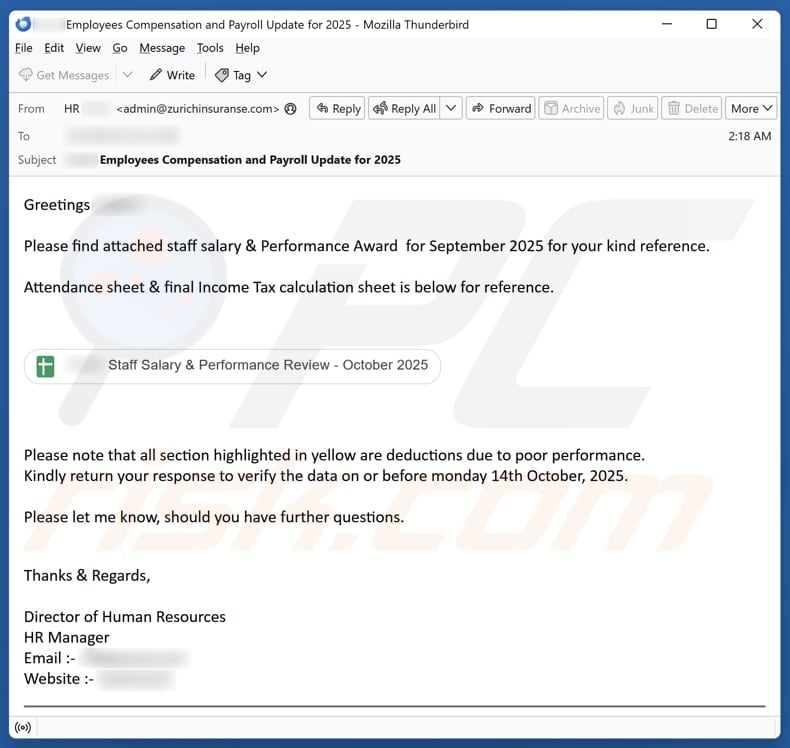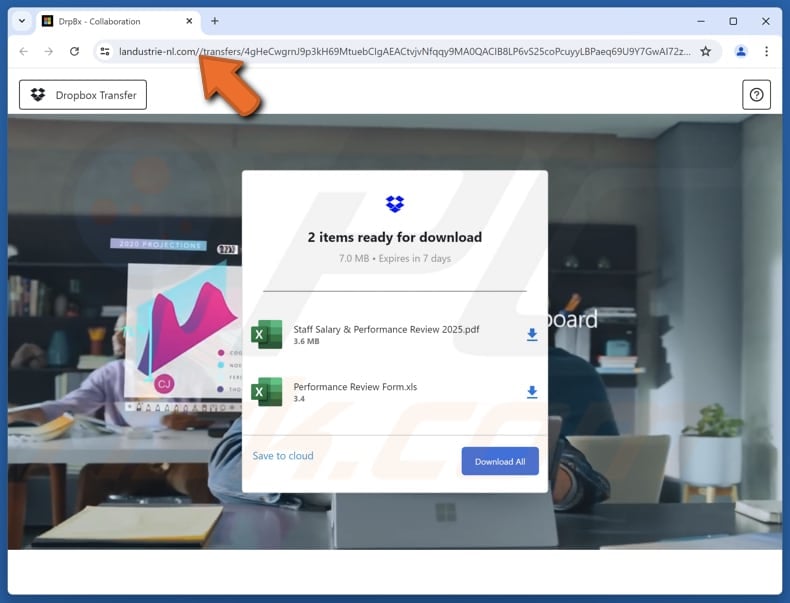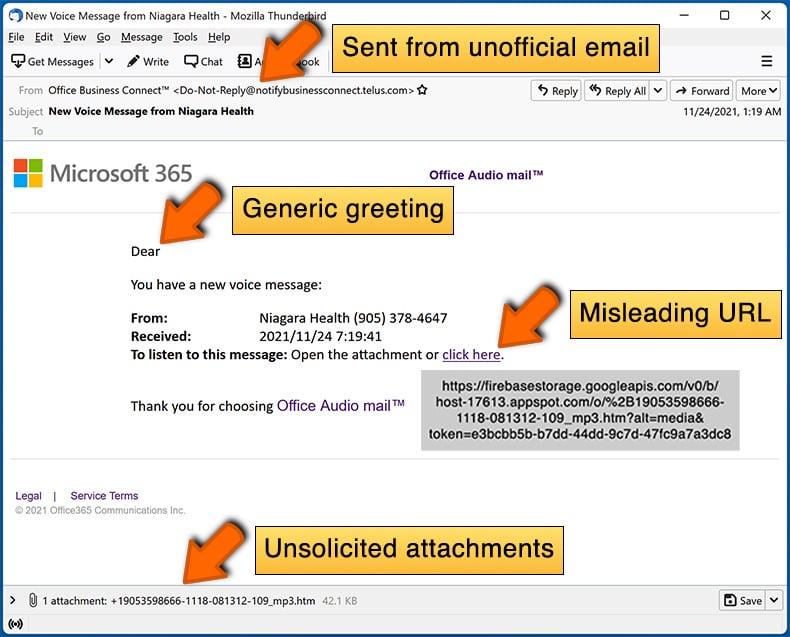How to identify scams like "Salary & Performance Award"
Phishing/ScamAlso Known As: Salary & Performance Award phishing email
Get free scan and check if your device is infected.
Remove it nowTo use full-featured product, you have to purchase a license for Combo Cleaner. Seven days free trial available. Combo Cleaner is owned and operated by RCS LT, the parent company of PCRisk.com.
What kind of scam is "Salary & Performance Award"?
Our team has concluded that it is a scam email posing as a message from a director of Human Resources. It is designed to trick recipients into clicking the provided link and entering personal information. Such emails are known as phishing scams. Recipients should ignore this email to avoid account compromise and other issues.

More about the "Salary & Performance Award" scam email
This phishing email is disguised as a letter from a company's Human Resources department regarding employee compensation and payroll updates for 2025. It informs the recipient that the "attached" file contains details on September's staff salary and performance award.
The message also mentions deductions for poor performance, highlighted in yellow, and asks the recipient to verify the data by a specific date. Its purpose is to trick recipients into clicking the provided button labeled "Staff Salary & Performance Review - October 2025". Doing so opens a fake Dropbox site.
On this page, two fake documents are presented: "Staff Salary & Performance Review 2025.pdf" and "Performance Review Form.xls". Clicking "Download" loads a fake login website designed to steal login credentials. This information can be exploited to gain access to email, banking, gaming, or other accounts, depending on where the compromised details are used.
Fraudsters can use the compromised accounts to make unauthorized purchases or transactions, send scam emails, deliver malware, harvest additional personal information, and more. Thus, it is highly advisable to examine emails before interacting with them to avoid these risks.
| Name | Salary & Performance Award Email Scam |
| Threat Type | Phishing, Scam, Social Engineering, Fraud |
| Fake Claim | The email contains compensation and payroll updates |
| Disguise | Email from a company's Human Resources department |
| Relate Domain | landustrie-nl[.]com |
| Detection Names (landustrie-nl[.]com) | N/A (VirusTotal) |
| Symptoms | Unauthorized online purchases, changed online account passwords, identity theft, illegal access of the computer. |
| Distribution methods | Deceptive emails, rogue online pop-up ads, search engine poisoning techniques, misspelled domains. |
| Damage | Loss of sensitive private information, monetary loss, identity theft. |
| Malware Removal (Windows) |
To eliminate possible malware infections, scan your computer with legitimate antivirus software. Our security researchers recommend using Combo Cleaner. Download Combo CleanerTo use full-featured product, you have to purchase a license for Combo Cleaner. 7 days free trial available. Combo Cleaner is owned and operated by RCS LT, the parent company of PCRisk.com. |
Similar scam emails in general
These emails are usually designed to look like official, important notifications or other messages from service providers, organizations, or other entities. Their purpose is to trick recipients into revealing personal information and sometimes infecting computers. It is important to be careful with such emails to avoid potential consequences.
More examples of scam emails are "DHL Package Is Ready For Delivery", "Join Google Meet", and "Migration To New Email Interface".
How do spam campaigns infect computers?
Malware is often spread through email by hiding it inside attachments, such as Word or Excel files, PDFs, scripts, executable (.exe) files, archives like ZIPs and RARs, or other files. Opening these attachments or performing extra actions, such as enabling macros, can trigger the infection.
Emails used to distribute malware may also include links leading to fake or compromised websites. Visiting such pages can result in automatic malware downloads or trick users into running malicious software themselves.
How to avoid installation of malware?
Do not open unexpected or irrelevant files (or links) in suspicious emails or other types of messages. Be cautious when visiting untrustworthy websites and avoid clicking on pop-ups, ads, or suspicious elements they display. Download software only from reliable sources, such as official pages or trusted app stores.
Do not consent to receive notifications from questionable sites. Also, keep your operating system, apps, and antivirus software up to date and perform regular system scans.
Text presented in the "Salary & Performance Award" email letter:
Subject: ******** Employees Compensation and Payroll Update for 2025
Greetings ********,
Please find attached staff salary & Performance Award for September 2025 for your kind reference.
Attendance sheet & final Income Tax calculation sheet is below for reference.
******** Staff Salary & Performance Review - October 2025Please note that all section highlighted in yellow are deductions due to poor performance.
Kindly return your response to verify the data on or before monday 14th October, 2025.Please let me know, should you have further questions.
Thanks & Regards,
Director of Human Resources
HR Manager
Email :- ********
Website :- ********
The fake page included in this scam (it leads to a fake login site):

Instant automatic malware removal:
Manual threat removal might be a lengthy and complicated process that requires advanced IT skills. Combo Cleaner is a professional automatic malware removal tool that is recommended to get rid of malware. Download it by clicking the button below:
DOWNLOAD Combo CleanerBy downloading any software listed on this website you agree to our Privacy Policy and Terms of Use. To use full-featured product, you have to purchase a license for Combo Cleaner. 7 days free trial available. Combo Cleaner is owned and operated by RCS LT, the parent company of PCRisk.com.
Quick menu:
- What is Salary & Performance Award phishing email?
- Types of malicious emails.
- How to spot a malicious email?
- What to do if you fell for an email scam?
Types of malicious emails:
![]() Phishing Emails
Phishing Emails
Most commonly, cybercriminals use deceptive emails to trick Internet users into giving away their sensitive private information, for example, login information for various online services, email accounts, or online banking information.
Such attacks are called phishing. In a phishing attack, cybercriminals usually send an email message with some popular service logo (for example, Microsoft, DHL, Amazon, Netflix), create urgency (wrong shipping address, expired password, etc.), and place a link which they hope their potential victims will click on.
After clicking the link presented in such email message, victims are redirected to a fake website that looks identical or extremely similar to the original one. Victims are then asked to enter their password, credit card details, or some other information that gets stolen by cybercriminals.
![]() Emails with Malicious Attachments
Emails with Malicious Attachments
Another popular attack vector is email spam with malicious attachments that infect users' computers with malware. Malicious attachments usually carry trojans that are capable of stealing passwords, banking information, and other sensitive information.
In such attacks, cybercriminals' main goal is to trick their potential victims into opening an infected email attachment. To achieve this goal, email messages usually talk about recently received invoices, faxes, or voice messages.
If a potential victim falls for the lure and opens the attachment, their computers get infected, and cybercriminals can collect a lot of sensitive information.
While it's a more complicated method to steal personal information (spam filters and antivirus programs usually detect such attempts), if successful, cybercriminals can get a much wider array of data and can collect information for a long period of time.
![]() Sextortion Emails
Sextortion Emails
This is a type of phishing. In this case, users receive an email claiming that a cybercriminal could access the webcam of the potential victim and has a video recording of one's masturbation.
To get rid of the video, victims are asked to pay a ransom (usually using Bitcoin or another cryptocurrency). Nevertheless, all of these claims are false - users who receive such emails should ignore and delete them.
How to spot a malicious email?
While cyber criminals try to make their lure emails look trustworthy, here are some things that you should look for when trying to spot a phishing email:
- Check the sender's ("from") email address: Hover your mouse over the "from" address and check if it's legitimate. For example, if you received an email from Microsoft, be sure to check if the email address is @microsoft.com and not something suspicious like @m1crosoft.com, @microsfot.com, @account-security-noreply.com, etc.
- Check for generic greetings: If the greeting in the email is "Dear user", "Dear @youremail.com", "Dear valued customer", this should raise suspiciousness. Most commonly, companies call you by your name. Lack of this information could signal a phishing attempt.
- Check the links in the email: Hover your mouse over the link presented in the email, if the link that appears seems suspicious, don't click it. For example, if you received an email from Microsoft and the link in the email shows that it will go to firebasestorage.googleapis.com/v0... you shouldn't trust it. It's best not to click any links in the emails but to visit the company website that sent you the email in the first place.
- Don't blindly trust email attachments: Most commonly, legitimate companies will ask you to log in to their website and to view any documents there; if you received an email with an attachment, it's a good idea to scan it with an antivirus application. Infected email attachments are a common attack vector used by cybercriminals.
To minimise the risk of opening phishing and malicious emails we recommend using Combo Cleaner Antivirus for Windows.
Example of a spam email:

What to do if you fell for an email scam?
- If you clicked on a link in a phishing email and entered your password - be sure to change your password as soon as possible. Usually, cybercriminals collect stolen credentials and then sell them to other groups that use them for malicious purposes. If you change your password in a timely manner, there's a chance that criminals won't have enough time to do any damage.
- If you entered your credit card information - contact your bank as soon as possible and explain the situation. There's a good chance that you will need to cancel your compromised credit card and get a new one.
- If you see any signs of identity theft - you should immediately contact the Federal Trade Commission. This institution will collect information about your situation and create a personal recovery plan.
- If you opened a malicious attachment - your computer is probably infected, you should scan it with a reputable antivirus application. For this purpose, we recommend using Combo Cleaner Antivirus for Windows.
- Help other Internet users - report phishing emails to Anti-Phishing Working Group, FBI’s Internet Crime Complaint Center, National Fraud Information Center and U.S. Department of Justice.
Frequently Asked Questions (FAQ)
Why did I receive this email?
Instead of targeting one person, scammers use lists of stolen email addresses (obtained through data breaches, deceptive pages, or similar methods) to reach many recipients at once.
I have provided my personal information when tricked by this email, what should I do?
Change every compromised password immediately if your login information was leaked. Contact your bank and local authorities if financial or personal ID data is involved.
I have downloaded and opened a malicious file attached to an email, is my computer infected?
If the downloaded file is an executable (.exe), your computer could already be infected. Other types of malicious files, such as documents, often need you to enable macros or take other actions before the malware executes.
I have read the email but did not open the attachment, is my computer infected?
Your device stays safe when you just open an email. It becomes vulnerable only if you open malicious attachments or click suspicious links.
Will Combo Cleaner remove malware infections that were present in email attachment?
While Combo Cleaner can find and remove most malware, a full system scan is strongly advised since some advanced threats may be hidden.
Share:

Tomas Meskauskas
Expert security researcher, professional malware analyst
I am passionate about computer security and technology. I have an experience of over 10 years working in various companies related to computer technical issue solving and Internet security. I have been working as an author and editor for pcrisk.com since 2010. Follow me on Twitter and LinkedIn to stay informed about the latest online security threats.
PCrisk security portal is brought by a company RCS LT.
Joined forces of security researchers help educate computer users about the latest online security threats. More information about the company RCS LT.
Our malware removal guides are free. However, if you want to support us you can send us a donation.
DonatePCrisk security portal is brought by a company RCS LT.
Joined forces of security researchers help educate computer users about the latest online security threats. More information about the company RCS LT.
Our malware removal guides are free. However, if you want to support us you can send us a donation.
Donate
▼ Show Discussion